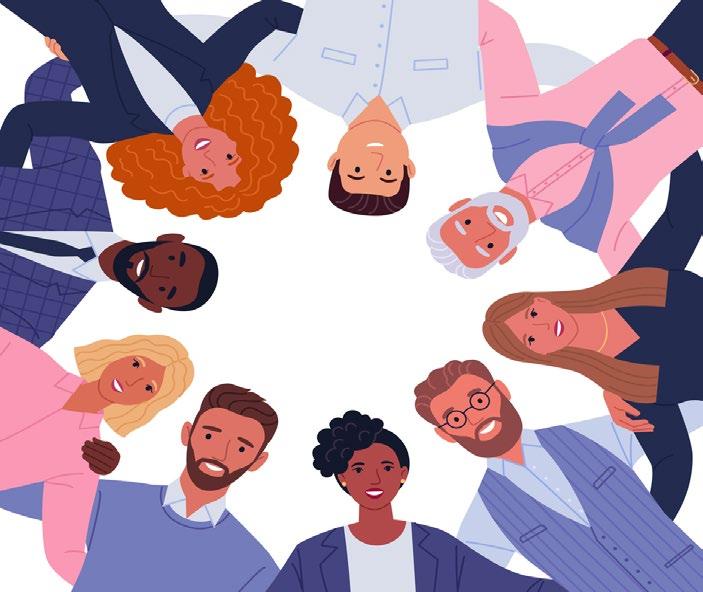
6 minute read
13 Diversity in the Workplace Statistics Every Company Needs to Know
from EOEJournal JULY 2023
by EOE JOURNAL
by Patrick Glynn
WHY CHOOSE US?
Advertisement
Here in the First Community family (First National Bank Texas, First Convenience Bank, First Heroes National Bank, First Community Mortgage and First Community Servi ces), we are fiercely proud of our past and excited about our bright future. Independently owned, with more than 300 locations in Texas, Arizona, Arkansas and New Mexico, we offer growth and advancement in a fun and fast-paced environment. Our company provides an educational atmosphere, enabling employees to achieve their highest career potential. We are pleased you have considered advancing your career with us.
POSITIOns dlldlldBLE
No matter what your specialty is, chances are there is a position for you in the First Community family of banks. Positions range from frontline sales to customer service, clerical, support services and managerial positions. Our account holders are very diverse, and we are proud to accommodate them with a diverse workforce that includes bilingual employees.
Competitive pay I Professional T r aining I Tuition Assistance Program I Health, Dental, Prescription Drug, and V ision Plan I Personal and Vacation Pay I 401 (K) Plan visit our website at www.1stnb.com/careers

Diversity in the workplace can offer a plethora of benefits to your company, including adding the diversity of thought and general cultural intelligence to your workplace. However, there are other tangible, impactful benefits of diversity in the workplace, backed up by statistics.
We’ve compiled a list of 13 diversity in the workplace statistics that will provide you with unique insights of trends and benefits of diversity. Within each section, we’ll discuss the stat impacts business results and how you can truly value people in your organization. Let’s get started.
WHY IS DIVERSITY IMPORTANT IN THE WORKPLACE?
Diversity in the workplace is essential for several reasons. First, it helps to ensure that all voices and different perspectives are represented and heard. This can be especially important in decision-making situations. In addition, a diverse workforce can help to foster a climate of creativity and innovation. When people with different backgrounds and experiences come together, they can share ideas and find new solutions to problems.
Diversity can also help businesses better reflect the communities they serve. By hiring a diverse workforce, companies can send a message that they value inclusion and respect for all. Diversity is an essential component of any thriving business.

Finally, as we’ll discuss in upcoming sections, diversity can have a positive impact on your business’ profits.
All of this belief is backed up by raw statistics that prove the benefits of diversity in the workplace. We’ll break these statistics down into categories (benefits, trends, gender, etc.), and discuss how they can be of service to your business.
The Bank will be known as an inclusive organization where diversity is respected and leveraged to effectively serve our region, The Federal Reserve System and the Treasury. Our words, actions and culture promote a workplace of inclusion and belonging where all employees have the same opportunity to contribute and succeed.

Benefits Of Diversity In The Workplace Statistics
1. Companies with diverse executive leadership and board teams earn more in profits.
According to a 2021 McKinsey study, companies with diverse boards and executive leadership earn more in profits.
Specifically, companies in the top 25 percent in gender diversity were likely to out-earn companies in the bottom 25 percent in gender diversity by… 25%. Also, the top ethnically and culturally diverse companies out-profited the least ethnically and culturally diverse companies by 36%.
Companies need to make an effort to recruit board members and executive leadership from a range of backgrounds. While contributing to the diversity of thought in the most important space, it also clearly leads to better results financially.
2.
Diverse businesses can capture new markets better
According to a 2013 study , more diverse companies are 70% more likely to enter and capture new markets.
One the reasons is because diverse management teams can better identify opportunities and solve problems. The diversity of thought leads to a diversity of ideas on how to capture new markets. To take advantage of this, companies need to ensure that they are recruiting and promoting from various backgrounds. Additionally, they must create an inclusive environment where all employees feel comfortable sharing their ideas. By prioritizing diversity, companies can position themselves to succeed in today’s global marketplace.
3. Diverse companies produce higher innovation revenues
A 2020 study found that companies with more diversity had 19% higher innovation revenues. This showcases the connection between diversity and innovation.

The explanation for this? The study said that “increasing the diversity of leadership teams leads to more and better innovation and improved financial performance.” Highly innovative teams bring new ideas into being faster through brainstorming sessions and exchanges of differing perspectives on problems or projects. However, these insights can only occur when there’s full representation across racial, gender, ethnic, and cultural lines.
Diversity Trends In The Workplace Statistics
4. By 2044, minority groups will reach majority status
Historically underrepresented groups, like African Americans,
Asian Americans, and Hispanics , will be expected to make up the majority of the United States population by 2044.
This shift has far-reaching implications for businesses, which must adapt their diversity practices to reflect the country’s changing demographics.
While 2044 may seem a long way off, businesses must start making these changes (if they haven’t already) to stay ahead of the curve. By preparing for the future and making their operations more inclusive, companies can position themselves to succeed in an increasingly diverse America.
General Population Info
5. Racial and ethnic minorities make up 48% of Gen Z
According to a report from Pew Research Center, nearly half of Gen Zers (people born between the mid-1990s to mid-2010s) are non-white.
As the workforce grows increasingly diverse by the generation, companies must do more to ensure that their teams reflect the society they operate in. Gen Z is already pushing companies to do this , as we’ve discussed in a previous article. More than 80% of Gen Zers surveyed by Monster said a company’s commitment to diversity practices was “important when choosing an employer.” Another poll found 75% of people in Gen Z would reconsider applying at a company if they weren’t satisfied with their diversity and inclusion efforts.
This statistic is a powerful reminder that the needs of minority groups must be considered when making decisions about company policies and practices. By prioritizing diversity, equity, and inclusion, organizations can stay ahead of the curve and position themselves for success in the 21st century.
6. According to the 2020 Census, whites and non-Hispanics are shrinking
In 2020 in the United States, individuals who self-identify as white or non-Hispanic dropped below 58% of the population for the first time in history. It fell from 63.7% in 2010.
This shift is driven by several factors, including immigration, fertility rates, and population aging. Consequently, we can expect the workforce to become increasingly diverse in the years to come.
This shift has profound implications for businesses and organizations across the country. As the workforce becomes more diverse, companies must ensure that their policies and practices are inclusive of all employees from all backgrounds. This includes everything from ensuring job descriptions are free of bias to offering training on unconscious bias and cross-cultural communication.

We at IEEE realize how fortunate we are to work with the best and brightest. Our mission is to advance technology for humanity, and we do so from one of the best places to work in New Jersey.
fortunate we are to work with the mission is to advance technology from one of the best places www.ieee.org to view details about four
Los Alamitos, Piscataway,
Come Join Us! Visit www. ieee.org to view details about open positions in one of our four offices: Los Alamitos, CA; New York, NY; Piscataway, NJ; and Washington, DC
The benefits of such diversity are well-documented. A more diverse workforce can lead to improved creativity and innovation and a better understanding of and sensitivity to different cultures. In an increasingly global economy, these are invaluable skills.
Gender Diversity In The Workplace Statistics
7. Organizations with an equal number of men and women generate up to 41% more revenue
We’ve discussed how general diversity is good for business, but this stat hammers down how gender diversity and equality can impact profits.
Companies should invest in gender diversity initiatives and promoting women to leadership positions across their company.
8. Women are underrepresented at every level of the corporate ladder
According to a 2021 study by McKinsey , “women remain underrepresented across the corporate level.” The worst levels of underrepresentation come at the C-suite and senior vice president level, where women make up between 25% and 30% of all positions despite making up just over half of the workforce. Gains have been made from 2016 to 2021, but nevertheless, underrepresentation is present across the board.
RACIAL/ETHNIC DIVERSITY IN THE WORKPLACE STATISTICS
9. White job seekers are 2.1% likelier to receive an interview callback than black applicants
Continued on page 27
Family Is At The Heart Of Everything We Do

What






